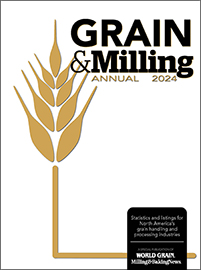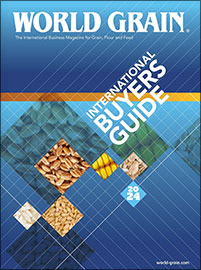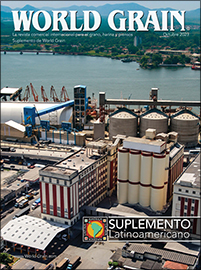
Country Focus 2024
KANSAS CITY, MISSOURI, US — These are the 12 nations at which World Grain took an in-depth look through its monthly Country Focus series in 2024. Revisit the locations and the perspective they provide on global grain, flour and feed issues:

Country Focus 2024

January - Australia
Australia has a diverse agricultural sector, producing a wide range of crops, including significant amounts of wheat, barley and canola. After a three-year drought came to an end in 2020, many agricultural regions moved from very poor to very good conditions within the span of a season. The nation achieved a record-setting A$94 billion in gross value for agricultural production in 2022-23. Read more → Country Focus: Australia

February - Zimbabwe
Zimbabwe’s economy is heavily reliant on agriculture, accounting for 17% of the gross domestic product and providing 60% to 70% of the nation’s employment. The performance of agriculture is a key determinant of rural livelihood resilience and poverty levels. Corn is the dominant crop, with use as a feed grain and a staple food for most of the population. Wheat is the second most important grain crop and is used to produce flour and semolina. Read more → Country Focus: Zimbabwe

March - Saudi-Arabia
Saudi Arabia is a net food importing country but is self-sufficient in some areas, including fresh milk, table eggs, dates and vegetables. It is a net importer of wheat, barley, corn and rice. It faces multiple challenges in expanding agriculture production, including a hot and dry climate with low precipitation, sandy soils with low fertility, high incidence of animal disease and pests and water scarcity. Read more → Country Focus: Saudi Arabia

April - Thailand
Agriculture overall is an important sector in Thailand, employing about 30% of the labor force, according to the United Nations. Although rice production is holding steady, weather-related challenges are a constant worry for Thailand, which relies heavily on the crop as a food staple and export commodity. All growing regions in Thailand are impacted by erratic weather patterns, in particular droughts and floods, that have increased in frequency and intensity. Read more → Country Focus: Thailand

May - United-Kingdom
Agriculture in the UK is intensive, highly mechanized and efficient by European standards, but accounts for only 0.6% of the UK’s gross domestic product. The industry produces 58% of its food needs but is heavily reliant on imports to meet the demand of the UK consumer. All main crops – wheat, oats, barley rapeseed - saw production drop in 2023 due to unseasonably wet and windy weather. The UK also continues to deal with the fallout from Brexit, its official departure from the European Union in 2020. Read more → Country Focus: United Kingdom

June - Kazakhstan
Agriculture is a key part of Kazakhstan’s economic, social and environmental development and is Central Asia’s largest grain producer and the only significant exporter. It also has significant agriculture potential with the world’s fifth largest endowment of agricultural land with 25 million hectares of arable land and more than 70 million hectares of pastureland. In addition to wheat, Kazakhstan produces barley, cotton, sunflower seed and rice. The government is looking to take advantage of the sector’s untapped potential for exports, jobs, and inclusive and sustainable growth. Read more → Country Focus: Kazakhstan

July - Mexico
Having free trade agreements with more than 40 countries, Mexico is a major participant in international agricultural trade. Crop production is the most important part of Mexico’s agriculture industry, accounting for 50% of output. Key crops include corn, sugar cane, sorghum, wheat, vegetables, fruits, beans, barley and coffee. Mexico has a large land mass with a diverse range of climates. It is the third largest agricultural producer in Latin America with 60.8 million acres of arable land. Read more → Country Focus: Mexico

August - Indonesia
While the tropical climate of Indonesia is favorable for growing multiple crops in the same plot of land within the same year, the nation grows no wheat. It relies entirely on imports to supply its mills and serve as a feed ingredient. Comprised of more than 17,500 islands, Indonesia has vast and abundant fertile soil, allowing it to produce a variety of agricultural products. Key commodities include palm oil, rice, corn and soybeans. Agriculture is a significant part of the economy, contributing 12.53% to gross domestic product and employing 29% of the workforce. Read more → Country Focus: Indonesia

September - Iraq
Agriculture is a significant part of Iraq’s economy, accounting for about 10% of gross domestic product and employing 8.4% of the workforce. About 22% of the country’s land mass is suitable for agriculture production but only 5 million hectares are cultivated. A large portion of the agricultural lands are under irrigation, but it still depends on rain-fed agriculture for grain and sheep production. Traditionally a major importer of wheat flour, Iraq is taking measures to boost its local production and reduce reliance on imports. Read more → Country Focus: Iraq

October - Russia
Agriculture plays a vital role in the nation’s economy, contributing 25% to net production output, employment and capital investment. Along with wheat, Russia’s main food crops include barley, corn (maize), rye, oats, millet, buckwheat, rice and pulses. Cultivated land totals 88 million hectares, with 31,000 agricultural enterprises, including 151,000 farmlands. Exports reached a record 60 million tonnes of grain (54 million tonnes of wheat) in 2023-24. The Russian grain industry has experienced significant consolidation in the last two years. Read more → Country Focus: Russia

November - Ukraine
Ukraine continues to face staggering losses to its people and economy as it approaches the three-year mark of Russia’s invasion. But its resilience is paying off as crop production rebounds and alternative trade routes and partners keep agriculture exports moving. The agriculture industry is the third largest contributor to Ukraine’s economy. Ukraine is well suited for agriculture production with a third of the world’s most fertile land. Its top three commodities include wheat, corn (maize) and sunflowers, with most production intended for export. Read more → Country Focus: Ukraine

December - Brazil
Brazil, already a dominant force in global agriculture as a leading producer and exporter of multiple commodities, is steadfastly working to grow its domestic wheat production. The wheat planted area has grown by nearly 80% in the last 40 years, improving domestic self-sufficiency from 30% to 80%. Brazil became the world’s top corn exporter in 2023, passing the United States, after gaining access to the Chinese market at the end of 2022. China is also a major destination for Brazil’s soybeans, which remain a popular option for farmers due to its profitability and relative ease to grow. Read more → Country Focus: Brazil













Current Issues & Directories




Popular Articles
Popular Galleries
-

IPPE 2025 showcases feed, grain solutions
ATLANTA, GEORIGA, US. — The International Production & Processing Expo (IPPE) at the Georgia World Congress Center in Atlanta is providing more than 80 hours of education programs, along with on-floor activities and networking opportunities for the animal food, meat and poultry and egg industries. Check out some of the suppliers and the scene on the expo floor in the Feed Hall.
-

GEAPS Exchange 2025 Supplier Showcase
The Grain Elevator and Processing Society’s (GEAPS) Exchange is Feb. 22-25 at the Kansas City Convention Center in Kansas City, Missouri, US. It includes an extensive educational lineup, special events and latest innovations in the grain handling and storage industry as well as an expo. Following are products and services from World Grain advertisers who will be exhibiting at GEAPS.